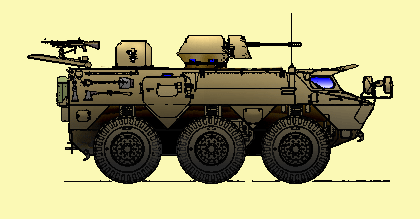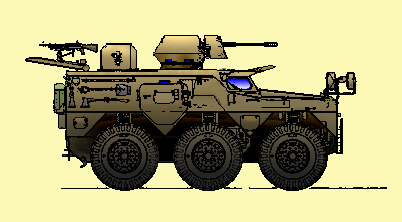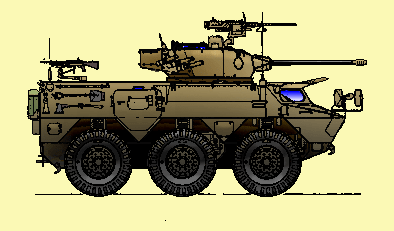


Jump to latest ideas on the Road Security Vehicle.
Even before the events portrayed in “Blackhawk Down” the short-comings of car configuration HMMWVs in the recon/combat role have been apparent.
A more capable vehicle appeared to be the Turkish Cobra vehicle, which uses many HMMWV components. Recently I watched a WW2 military reenactment that included three M8 Greyhound armoured cars and it occurred to me that there may be even better configurations for a HMMWV based armoured car.
M8 Greyhound
The M20 was a turretless version of the M8 intended to act as a command car and personel/cargo transporter. Standard equipment included a Bazooka.
Virtues of the original M8 were that it was reliable, fast, had good mobility and was a small compact vehicle. Some sources claim that the arrangement of the rear engine and cooling fans also made it a fairly quiet vehicle. On the downside the M8 had a wide turning circle, light armour and a not particularly useful 37mm main gun.
The idea is to build a vehicle of Greyhound configuration based on military truck or HMMWV parts. Given the extremely poor performance of the HMMWV in Iraq basing the vehicle on heavier truck components would seem the more prudent route. While we are at it we can improve the mine resisting and amphibious capabilities.
Dual-direction steering was a standard feature on German wartime armoured cars. Both the front and rear of the vehicles were well sloped and had equal levels of armour protection. For the turreted versions the “front” of the vehicle was whichever end pointed in the direction that you wanted to go. I’ve seen photos of armoured cars travelling together, some making the entire journey “backward”
Also useful would be a Quadristeer system or the ability to slew on the spot like a tracked vehicle or the Supacat ATVs. The French AMX-10 RC armoured car has this ability, which also offers it the potential to protect its wheels with armoured skirts.
The main role I see for this vehicle is for patrol and escort duties, so I have named it the Road Security Vehicle or RSV. Ralph Zumbro has suggested the name “Ridgeback”, which I like since it pays homage to the Rhodesians who pioneered vehicle mine-proofing.
Cross country reconnaissance is better performed by light tracked-vehicles such as the M113, Wiesel or Tankita or by systems much lighter than the HMMWV- bikes, ATVs, jeeps etc.
Variants.
Ralph Zumbro: We definitely need something in the Greyhound/Ferret class.
There’s a Canadian company that makes segmented wheels with removable tyre segments that are foam filled solids. About eight--twelve per wheel. Looks like they are crescent shapes that bolt to the rim and each will blow off the rim in pieces, leaving the rest of the tyre intact.. If one gets blown, the crew just unbolts it and bolts another in place. The good thing is that if one eighth of the tire is gone, the vehicle can still drive out of the kill zone and still fight. I think they are filled with foam, not air, although heavy foam with an inflatable core would work also.
PW: Possibly this tyre construction technique could be used with the segments filled with water. Water filled tyres were standard for mine resistant Rhodesian and South African vehicles. As well as giving a smoother ride than a solid tyre it was found that the water actually quenched some of the explosion, preventing explosive from combusting. A South African company called “Althane” has produced “Terra Track” tires for the Vickers OMC Rooikat. These can survive attack by 7.62mm small arms fire, eliminate the need for a central tire pressure regulation system and during flame trials self-extinguish after 5 secs. Average lifetime is 16,000km.
RZ: The frame/running gear penalty: In a tracked armored vehicle, the heavy hull serves as a frame, as all the running gear is bolted to it. In a light wheeled vehicle, you have to have a frame, which does not contribute to armor weight. In a M113, for instance, the torsion bars simply go into sockets in the hull, and In-arm, after-market roadwheel arms are simply bolted to the hull plate. In a frame vehicle like the LAV, there is a parasitic load consisting of a frame, up to four transaxils and their attendant drivelines and gear boxes
PW: I suggested to Ralph that maybe the same construction techniques used on light tracked vehicles could be applied to a wheeled vehicle with a monocloque hull. Constructing a suspension system more akin to that of a tracked vehicle would further reduce the need for pneumatic tires. Many current armoured cars are simply armour-plated trucks. Why not design a dedicated armoured car?
RZ: You got it! Start with a blank sheet and use SA type engineering, build a fully armored hull with a blast deflecting V bottom and go from there. The differentials on the Hummer, BTW are attached to the frame. We could simply take that hardware and attach it to a hull and go from there. This is starting to get exciting, as the hardware is already available, this thing is BUILDABLE.
PW: This prompts the question:
The same effect can be obtained by controlling the speed of the electric motors that power the individual wheels, and there would be no differentials to get hung up on rutted roads.
RZ: You need the differentials for turning radius. The inside wheel on any turn runs a tighter circle and must be allowed to run slower or it will lose traction. However, with an electric motor plugged right into a solid mounted differential, there won't be much friction loss to gears.
PW: What I’m thinking about is “virtual differentials” -a control program that slows the motors on one side when the steering is turned in that direction. The United Defense HED-D mentioned on the Hybrid page has a “gearless” infinitely variable transmission system and each track controlled independently so track speed is controlled throughout the turn.
RZ: I took a good long read in Jane’s last night and noticed that most REAL armored cars use hulls rather than chassis or frame supports. The British Fox vehicle nets out at about six tons and the book says that a C-130 can take three of them (2 airdrop rigged). Pull the RARDEN gun, insert an ASP-30 and put a couple of 70mm FFAR pods on the sides of the turret and you’ve got the firepower. Take the Jaguar petrol engine out and replace it with the Capstone/battery/electric motor propulsion unit and you’d really have something.
PW: My current preference is for a hybrid-electric vehicle with six evenly spaced wheels like the FV603 Saracen/ FV601 Saladin family of vehicles. These could keep running with any two wheels blown off by mines.
Armament would be a RARDEN or Bushmaster II gun fitted alongside a MG and a 81mm gun-mortar. The mortar could be used to fire canister, HESH, HEAT or CS. The 30mm would be particularly effective against light infantry/guerillas with ABM ammunition. A “Heavy Support” variant could mount a 60mm HVMS, T 60/70 or 76mm GT4.
Update.
On further reflection it seems to me that a convoy escort force will require at least two forms of vehicle. One vehicle which we will call the Ridgeback will be a fire support variant along the lines of a traditional armoured car. The other vehicle, that we will call the Shepherd, will more closely resemble a personnel carrier although I use this term with reservation since I see it more closely resembling an ACAV in application and configuration. This latter vehicle would not be designed to carry a full infantry squad and a more likely crew would be commander/gunner, driver, co-driver, two wing gunners and one or more loaders/assistant gunners and lots of ammo. Crews would have heavy body armour and personal weapons as suggested here.
 Shepherd (Mid-Engine) |
 Shepherd (Front-Engine) |
 Ridgeback |
The basic hull of both vehicles would be very similar and the vehicles would incorporate a large number of components that are already used in the military trucks that they would often escort. I see these vehicles as being an integral component of transport companies so this approach will greatly simplify maintenance and logistics.
For both vehicles I favour a hull with six evenly-spaced wheels along the lines of the Saracen/Saladin family. This configuration increases the probability that the vehicle can keep moving in the event of wheel damage. Wheelspan of the vehicles should be the same as that of common military and civilian cargo vehicles allowing the vehicle to more easily traverse poor roads that have been rutted by traffic. As discussed above the vehicle should be capable of moving backwards at speed and slew-steering like the AMX-10RC
The vehicle would be designed from the wheels upwards to maximize its ability to resist mine attack. This is a feature to which insufficient attention has been paid in most of the military vehicles designed in the Northern Hemisphere and we need to pay more heed to the improvements made in this area by the Rhodesians and South Africans.
The other essential feature for a vehicle of this kind is that it should have a driving position suited to high-speed driving. Many trucks have a cruising speed of at least 55mph and it is understandable drivers will use this speed to minimize the time spent in likely ambush areas. Any military vehicle used to escort such convoys will need to be able to move at the same speeds. For this reason the escort vehicle should feature armoured windscreens for maximum visibility. Armoured shutters can be lowered over these screens in the event of action. It may be prudent to have a co-driver seated beside the driver. The co-driver can handle tasks such as navigation and provides an extra pair of eyes to spot mines or likely ambushes. This crewman can also act as radio-operator, bow gunner and could be provided with a duplicate set of driving controls.
The internal layout of the two vehicles will probably differ. For the Shepherd personnel/armament carrier vehicle desirable features include a personnel compartment with a large rear-opening door(s) and roof hatches. Main armament for this vehicle would be a one-man turret mounting a 30mm ASP cannon. Behind this would be at least two “wing guns”. These would be provided with gunshields and either skate rail or elbow-bracket mounted allowing them to fire forward and to the rear as well as to the sides. These weapons would probably be .50 HMGs or Gecal mini-guns although other weapons such as the Mk19 automatic grenade launcher would also be possible. This configuration suggests that the engine would either be mounted at the front of the vehicle (like the Alvis Saracen or Humber Pig) or behind the driver (as in the French VAB, German Fuchs and Japanese Type 82). Many military vehicles that mount the engine behind the driver have room for a gangway connecting the driving position with the passenger section.
For the armoured car/FSV variant it is desirable to mount the engine in the rear of the vehicle so that the turret mounted armament has greater depression and reduced dead space when firing forward. Vehicles such as the Japanese Type 87, Cadillac Gage V-150 Commando/M706 and (presumably) the M1117 ASV mount their engine on the rear of the hull and have space for a passageway to a single rear door. (Note the despite their six-wheel configuration the Type 82 and 87 both have a side door on the right side between the first and second wheels and on the left between the second and third. I’ve reversed this on my illustration to reflect that the suggested vehicle has left-hand drive).
Main armament of the Ridgeback armoured car would probably be a 35/50mm cannon, preferably in 50mm configuration. This would be supplemented by a pylon that can mount a pod of ATGW, FFARs or SAMs. Versions with a GT4 76mm or low-recoil 90mm gun or 60mm or 81mm gun-mortars are also possible. My preference is the 35/50mm since the vehicle will probably not need to halt to fire this weapon accurately.
Attacking a vehicle from behind is an obvious tactic for an RPG-armed foe. Both vehicle types would include a fold-down seat near a firing port and vision block in the rear door. The LAV-150 series of vehicles include a roof-hatch with a MG mounting in the passageway leading to the rear door and this feature may be worth copying for the Ridgeback. The roof hatch of the rear compartment of the Shepherd will probably resemble that of the M113. What is not commonly known is that a removable socket could be installed on the under-side of the rear personnel hatch cover of the M113 so that when it was in the open position a MG could be mounted for firing to the rear of the vehicle. This would be a useful fitting for the Shepherd.
By the Author of the Scrapboard : | |
|---|---|
 | Attack, Avoid, Survive: Essential Principles of Self Defence Available in Handy A5 and US Trade Formats. |
 | |
 | Crash Combat Fourth Edition Epub edition Fourth Edition. |
 | |
 | |